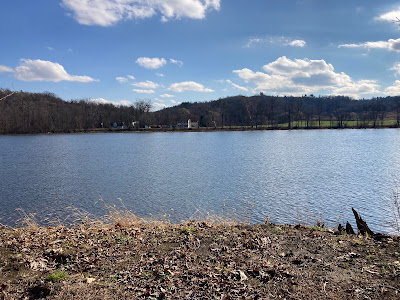Stillwater, New York - "We Crossed The Hudson In A Few Boats"
A handful of markers commemorate the 1777 march of the Convention Army. One is in Stillwater, New York, on the corner of Route 4 and Ferry Lane, a short distance from the west bank of the Hudson River. Its location puts it at what might be considered the start of the march. Some question if the crossing occurred there. Regardless of the answer, it only notes the crossing of "Brunswick Troops", not British troops who began crossing the river on October 18th. In an odd contrast, the Stillwater town history website notes only the crossing of British troops.
One of the Convention Army who crossed in 1777 noted that Stillwater was aptly named, as: "In this region, the Hudson is unusually sluggish for 3 Engl.[ish] miles and you hardly notice the motion the very slight motion of the water." [1] Today, an iron frame bridge spans the river about one-thousand feet below the ferry site, just north of where the Hudson is joined by the Hoosic River.
There was no bridge across the Hudson River in this area in 1777, no fixed bridge at least. Burgoyne bridged the river twice, first further north near Fort Edward on planks laid across bateaux, the flat bottomed cargo boats common on the waters of the Champlain Valley he had been using to transport supplies and equipment, but rising water had broken up that bridge as of mid-August, forcing the use of batteaux and a "scow" to complete the crossing - "... a most tedious piece of work". [2] A second floating bridge. build again using the bateaux and further testimony to combat engineering skills of his army, allowed him to pass his army across the Hudson from the east bank to the west bank above Schuylerville, but was noted as having been broken up on September 15th. [3]
American engineers did likewise. Colonel Jeduthan Baldwin and his workmen are credited with the construction of a bridge of logs functioning as rafts, floored with planks, rather than a pontoon bridge of bateaux as Burgoyne's engineers had built. First completed at Stillwater on September 10th, the bridge was floated twice further up the Hudson, moved first days after its completion, and then again in mid-October. [4] Presumably Baldwin's bridge had been dismantled by the time of the surrender. As a result, the crossing of the British and German prisoners of the Convention Army was made using "some batteaux and ... baggage ... on a big ferry." [5]
First to cross were the British. Massachusetts Militiaman David How, who with his regiment would escort British prisoners to Cambridge and Prospect Hill, would note that on the 18th: "This morning we all March'd to Stillwater got There in the afternoon And In Camped there The Enimy have been Crossing the river this Day." [6]
For most the crossing was likely uneventful, Lieutenant (Lord) Francis Napier noting "October 18. Crossed Hudsons River at Stillwater." [7] The river crossing was nearly a disaster for British Ensign Thomas Anburey. He and his companions could see as they crossed "... the army under General Gates marching to Albany, to join Putnam, the object of this was to give General Clinton a check..." His observations were distracted though, as "In crossing the river..." he wrote, "I nearly lost my baggage and those in the batteaux had a very narrow escape." A horse had become unruly he related, and jumped over the side of their boat, nearly upsetting it. [8]
The crossing took more than a day to complete, German commander Major-General Friedrich Riedesel writing that on the 18th, "... there being a scarcity of rafts, only the English were sent across." [9] Once the British troops were across, the Germans followed on the 19th. One noted "Early this morning, the German corps began to make the crossing over the Hudson", another, "The 19th, we crossed the Hudson in a few boats." As would seem to be the case throughout their march, the Germans moved by regiment, the Hesse-Hanau being the first over, with all across by 4:00 PM. [10]
Once all were across, the army would separate. British troops followed the Hoosic River Valley to Williamstown, Massachusetts, and Germans the Hudson River Valley to New City (now part of Troy), then on through Kinderhook, New York, before heading east to Great Barrington. Each element was on its own route through western Massachusetts, and another ferry crossing, this one over the Connecticut River.
If you are not able to visit the crossing site of the Convention Army over the Hudson River in person, pictured below with the house of ferryman Conelius Vandenburg on the east bank in the distance, the town has posted a video drive-through of Stillwater on its website. The ferry marker shown above, now nearly 100 years old itself, makes its appearance at 27 minutes.
Next week - The March Begins - "We Had To Bivouac In Meadows Assigned To Us"
For more on the Convention Army's 1777 march from Saratoga to Boston, see:
1777 March Blog Home Overnight Stopping Points Towns and Villages Along the Way





Comments
Post a Comment